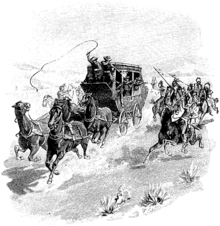Riding shotgun

Riding shotgun was used to describe the guard who rode alongside a stagecoach driver, ready to use his shotgun to ward off bandits or Indians. In modern use, it refers to the practice of sitting alongside the driver in a moving vehicle. The phrase has been used to mean giving actual or figurative support or aid to someone in a situation.[1] The phrase was coined in 1919.[2]
Etymology
The expression "riding shotgun" is derived from "shotgun messenger", a colloquial term for "express messenger", when stagecoach travel was popular during the American Wild West and the Colonial period in Australia. The person rode alongside the driver. The phrase "riding shotgun" was first used in 1919 by the The Ogden Examiner in May 1919, in a story titled "Ross Will Again Ride Shotgun on Old Stage Coach."
Driven by Alex Toponce and A. Y. Ross, an old fashioned stage coach made in 1853 and used on the Deadwood stage line in the early days of Wyoming, will appear in Ogden streets on the day of the Golden Spike celebration.Alex Toponce was in the early days the owner of a stage line. He will probably drive the old fashioned vehicle, while A. Y. Ross, famous in railroad circles as a fearless express messenger and who on several occasions battled with bandits on the plains, will probably ride "shotgun" as he did in the past.[2]
It was later used in print and especially film depiction of stagecoaches and wagons in the Old West in danger of being robbed or attacked by bandits. A special armed employee of the express service using the stage for transportation of bullion or cash would sit beside the driver, carrying a short shotgun (or alternatively a rifle), to provide an armed response in case of threat to the cargo, which was usually a strongbox. Absence of an armed person in that position often signaled that the stage was not carrying a strongbox, but only passengers.[2]
Historical examples
Tombstone, Arizona Territory
On the evening of March 15, 1881, a Kinnear & Company stagecoach carrying US$26,000 in silver bullion (about $638,614 in today's dollars) was en route from the boom town of Tombstone, Arizona Territory to Benson, Arizona, the nearest freight terminal.[3]:180 Bob Paul, who had run for Pima County Sheriff and was contesting the election he lost due to ballot-stuffing, was temporarily working once again as the Wells Fargo shotgun messenger. He had taken the reins and driver's seat in Contention City because the usual driver, a well-known and popular man named Eli "Budd" Philpot, was ill. Philpot was riding shotgun.
Near Drew's Station, just outside Contention City, a man stepped into the road and commanded them to "Hold!" Three Cowboys attempted to rob the stage. Paul, in the driver's seat, fired his shotgun and emptied his revolver at the robbers, wounding a Cowboy later identified as Bill Leonard in the groin. Philpot, riding shotgun, and passenger Peter Roerig, riding in the rear dickey seat, were both shot and killed.[4] The horses spooked and Paul wasn't able to bring the stage under control for almost a mile, leaving the robbers with nothing. Paul, who normally rode shotgun, later said he thought the first shot killing Philpot had been meant for him.[5] [6]
When Wyatt Earp first arrived in Tombstone in December 1879, he initially took a job as a stagecoach shotgun messenger for Wells Fargo, guarding shipments of silver bullion. When Wyatt Earp was appointed Pima County Deputy Sheriff on July 27, 1881, his brother Morgan Earp took over his job.[7]
Historical weapon
When Wells, Fargo & Co. began regular stagecoach service from Tipton, Missouri to San Francisco, California in 1858, they issued shotguns to its drivers and guards for defense along the perilous 2,800 mile route.[8] The guard was called a shotgun messenger and they were issued a Coach gun, typically a 10-gauge or 12-gauge, short, double-barreled shotgun.[9]
Modern usage
More recently, the term has been applied to a game, usually played by groups of friends to determine who rides beside the driver in a car. Typically, this involves claiming the right to ride shotgun by being the first person to call out "shotgun". While there are many other rules for the game, such as a requirement that the vehicle be in sight, nearly all players agree that the game may only begin on the way to the car.[10][11] In addition, a number of humorous rules for calling shotgun has been developed by organizations and individuals (for example, the "survival of the fittest rule").
See also
References
- ↑ "Define Shotgun at Dictionary.com". dictionary.reference.com. Dictionary.com. Retrieved 11 February 2013.
- 1 2 3 "Riding shotgun". phrases.org.uk. Retrieved 1 May 2010.
- ↑ O'Neal, Bill (1979). Encyclopedia of Western Gunfighters. Norman, OK: University of Oklahoma Press. ISBN 978-0-8061-2335-6. Retrieved 14 April 2011.
- ↑ "Tombstone, AZ". Retrieved 17 May 2011.
- ↑ "Wyatt Earp Trial: 1881—A Mysterious Stage Coach Robbery—Clanton, Holliday, Told, Leonard, Doc, and Ike". Retrieved 8 February 2011.
- ↑ "History Raiders". Retrieved 11 February 2011.
- ↑ WGBH American Experience: Wyatt Earp, Complete Program Transcript. January 25, 2010.
- ↑ Jones, Spencer (2004-06-01). "Revival Of The Coach Gun". Popular Mechanics. Retrieved 2007-03-18.
- ↑ Wilson, RL (1992). The Peacemakers: Arms and Adventure in the American West. New York: NAL. pp. 121, 197, 244. ISBN 978-0-7858-1892-2.
- ↑ "Shotgun Rules". bored.com. Retrieved 1 May 2010.
- ↑ Tom Dalzell (25 July 2008). The Routledge Dictionary of Modern American Slang and Unconventional English. Routledge. p. 877. ISBN 1-134-19478-1.
Further reading
- What's the origin of "riding shotgun"?
- Rules of shotgun, Shotgunrules.com, Retrieved 27 March 2015.
- The Shotgun Rules, version 1.1 by the Airborne Early Warning Association, Retrieved 27 March 2015.
- Rules of shotgun: The 25 Universal Rules of Order for Riding Shotgun By David A. Tomar, Retrieved 27 March 2015.